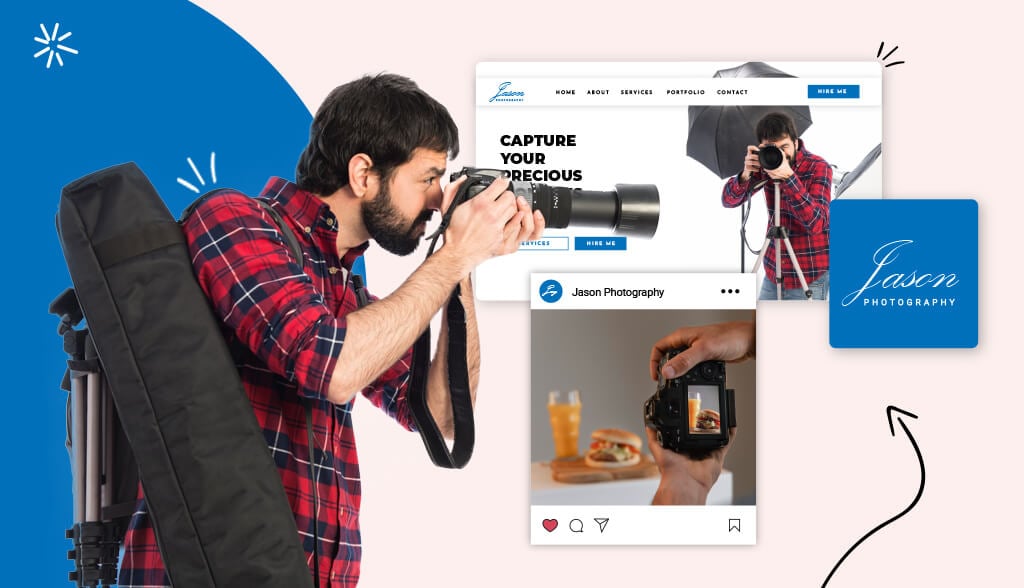
You’ve heard of a ‘brand story’ and that, as a business owner, you need one, but what does it mean? I interviewed our very own brand director, Tamar, to find out more about brand stories (trust me, she’s a serious pro).
In this post, you’re going to learn everything you need to be able to create your own brand story from scratch and use it as the foundation for your business. I know you’re busy building your business, so let’s get started.

Before you can even start creating your brand story, you need to understand what it is. As Tamar says, “the brand story is the element that ties everything together—the mission statement, vision, target audience, pain points, needs, and values – into a coherent story.”
Oh, and your brand story will be an actual story. “It’s a story that tells everything about your business in an emotional way that can relate to whoever you’re talking to,” Tamar explains.
Now, I know you’re waiting to see an example from a well-known business like Nike or Apple, but here’s the thing: no one is going to see your brand story.
“Your brand story is not something we advertise,” Tamar explains. “You won’t see Adidas or Coca-Cola’s brand story out there because it’s a guiding document for the business.”
So, if your brand story isn’t going to be seen by anyone, then why do you need it? Well, your brand story is actually very important for your business. “It’s extremely useful for connecting employees to the brand and for understanding what type of brand your business wants to be—the vibe you want to create.”
So, you know what a brand story is and why your business needs it, but how do you create one?
A brand story is a short paragraph or two that encompasses everything about your business— the pain, need, solution, and promise—in an emotional way. A brand story does its job if it evokes emotion—you need to make people feel something. So, how do you do that? First, you’ll need to answer these 3 questions:
Let’s go into a little more depth about each of these questions.
“The first thing to do when figuring out who you are as a brand is figuring out who you are,” Tamar suggests.
Tap into your emotional side when looking at who you are. Who you are is why you exist in this world, why you get up every morning to do what you do. This is all from an emotional perspective; in other words, why you get up in the morning to do what you do isn’t because you have to pay your bills.
You can ask yourself some of the following questions to help you answer this question:
Once you have these questions answered, you’ll have a better idea of who you are. Now, let’s move on to the second question: what are you selling?
Once you have these questions answered, you’ll have a better idea of who you are. Now, let’s move on to the second question: what are you selling?
What you sell helps form your unique value proposition, a statement that describes the benefits you offer customers and how you solve your customer’s needs and problems. To discover what you sell, you may want to answer the following questions:
“You can answer these questions in a functional way, but you should look at this from an emotional perspective,” Tamar explains. “For example, the same shoes can have different logos on them, and you’ll choose the Nike pair over New Balance because of the emotional connection you have with this brand—it spoke to you in a certain way, or you shared values with them.”
So why should anyone care about your business?
“So, you have a product/service, you know who you are, but why would anyone pay attention to you?” Tamar asks.
This is where you need to learn about your audience. “Understanding your audience, their pains, their needs, what makes them happy or sad—this will help you understand why they should care about your business.”
You want to connect with their lives in a way where they say, “I love Lululemon’s workout wear. I’ll never use another product because they understand me and solve my issue with excessive sweating. They understand my problem and solve it.”
To answer this question, you’ll need to do some audience research and learn about who your customers are. You’ll need to do 2 things: 1) conduct audience research, and 2) create an audience persona.
Read this post to conduct audience research. Once you’ve done that, read this post to learn how to create an audience persona.
So, as we just talked about, you need to know who you are, what you’re selling, who your audience is, and why anyone should care. Once you have those questions answered, you need to sit down and really write a story about yourself.
In your story, you want to cover who you are, the customer’s pain points, your solution, and what you offer them if they choose your business. Then, connect the dots.
“Write a story from the heart because this is a guiding document – no one will see it aside from yourself. So I would say, be open-minded for a couple of minutes and write your story,” Tamar suggests.
At first, it may be a bit challenging, but don’t give up. “This could be a great exercise on how to tell your product or services. Once you write it, rewrite it. And keep rewriting it until you have a concise paragraph or two. It’ll help you better understand your product and customers,” Tamar explains.
You may find that you’re not connecting with your story after you write it. It may even raise the question, “is this what I want to do as a business?” It’s a great exercise to help you better understand yourself.
To help create your brand story, Tamar recommends visiting your favorite brand’s website and looking at their about page. “Read what those brands say about themselves and how they write their story. You’ll see how they add their mission statement and pain points to connect with their audience,” she says.
A brand story isn’t just about the history of your company. It’s about communicating your company’s “why”—your mission and values. Use these to find common ground with your audience and to make your company relevant and meaningful to consumers.
Getting your audience to understand and care about your brand is a big part of getting them to trust you. And when they trust you, they’ll become happy and loyal customers.
Make your story an integral part of your brand, and use it to showcase your brand’s personality and strengthen your brand’s identity and appeal.
The information provided on this page is for information, educational, and/or editorial purposes only. It is not intended to indicate any affiliation between Tailor Brands and any other brand or logo identified on this page.

Products
Resources
@2024 Copyright Tailor Brands